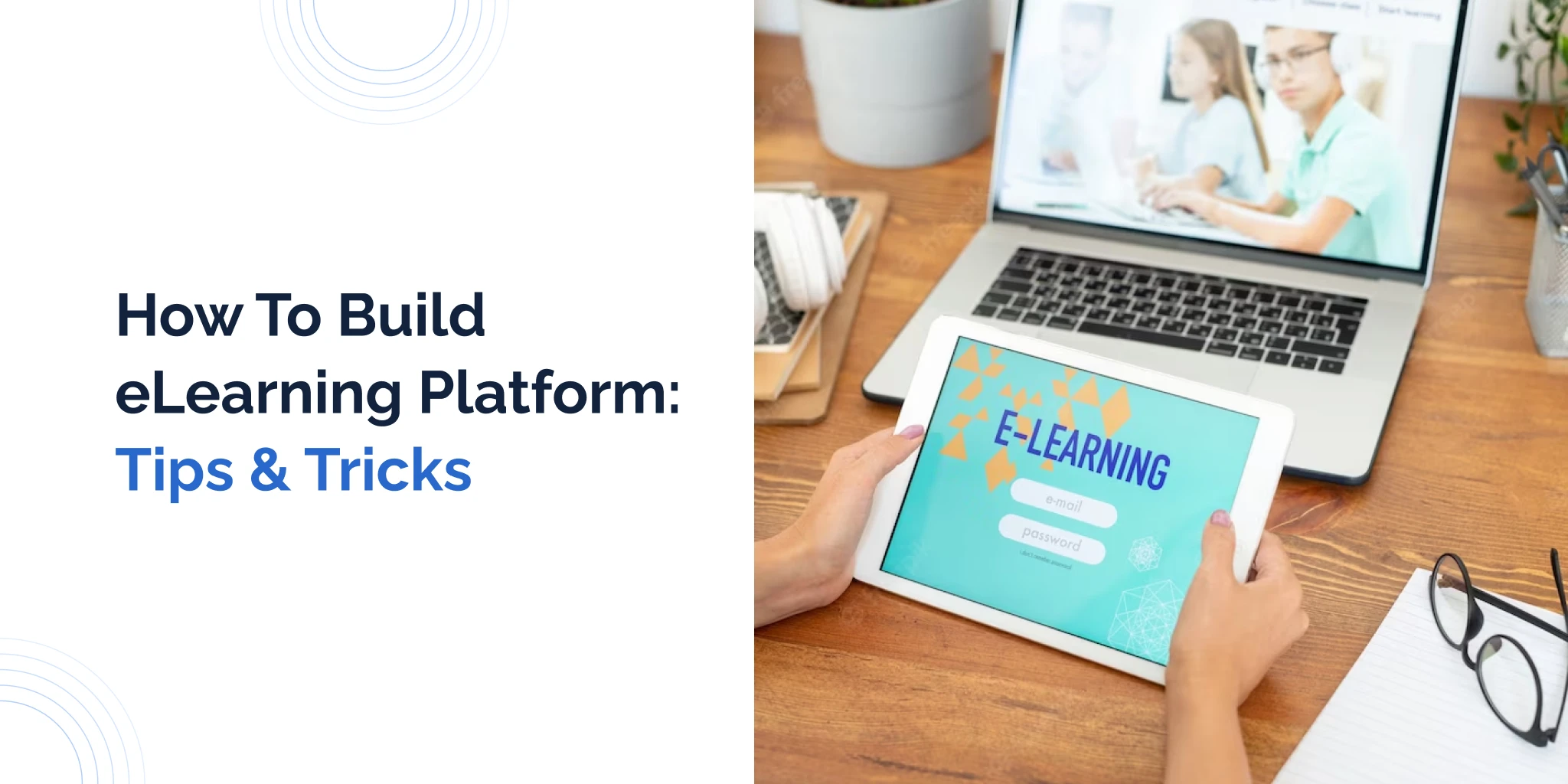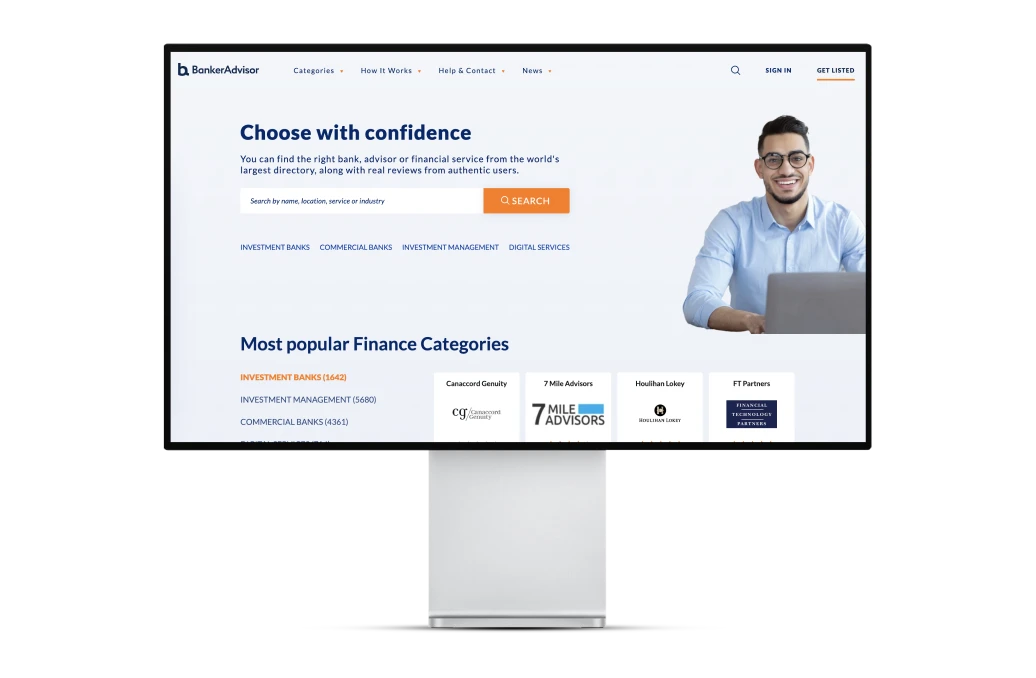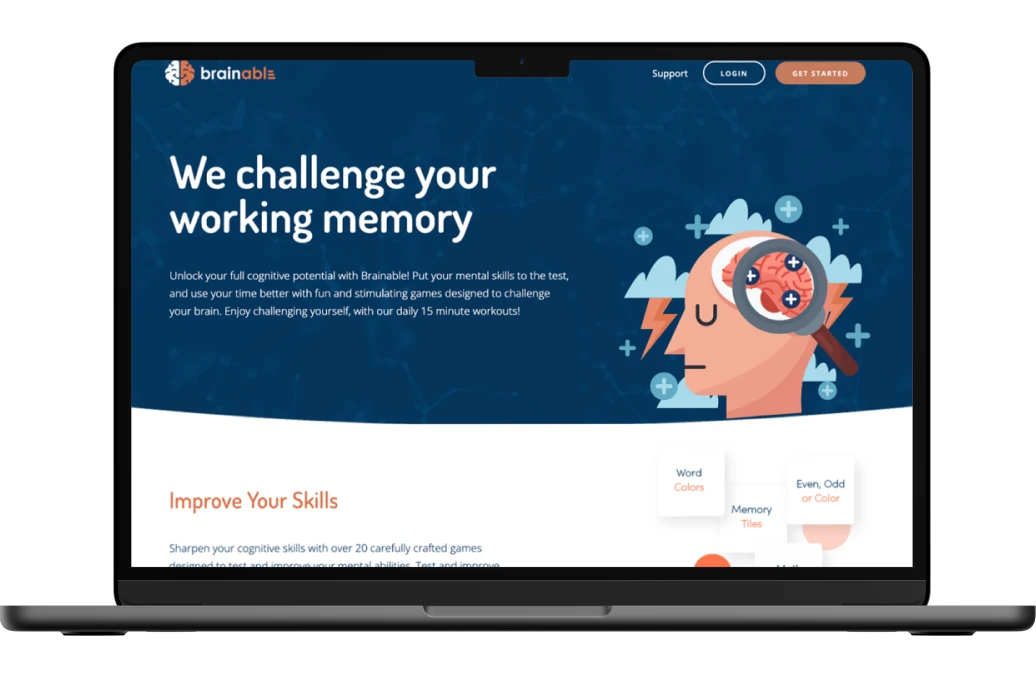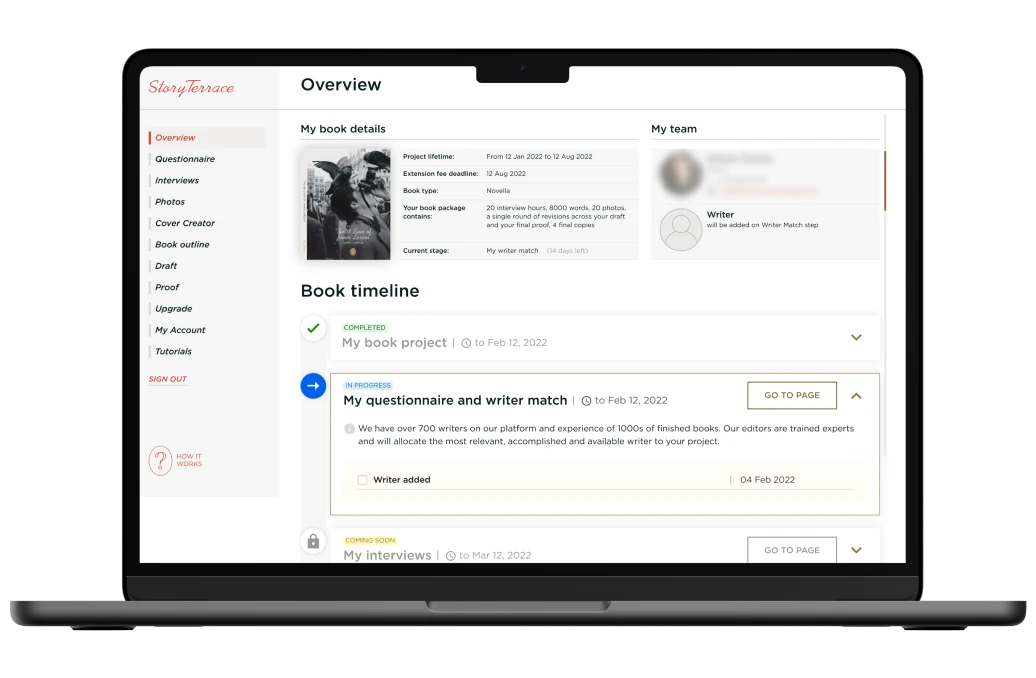Online learning platforms are a perfect addition to any education business. Learn how to create them in this article!
Learning is among the best pathways to improve one’s position in life. A coding course, for instance, can change lives by giving people an opportunity to enter a field with high income. In this light, it’s not surprising the demand for online learning platforms is rising. This tendency means the field benefits not only the users but also the providers of teaching services. Creating a high-quality online learning platform is a great business opportunity. Are you interested in starting one? This article provides insights into building a strong online learning platform. As you’ll see, the rules of success are clear in this field.
Benefits of Creating an Online Learning Platform
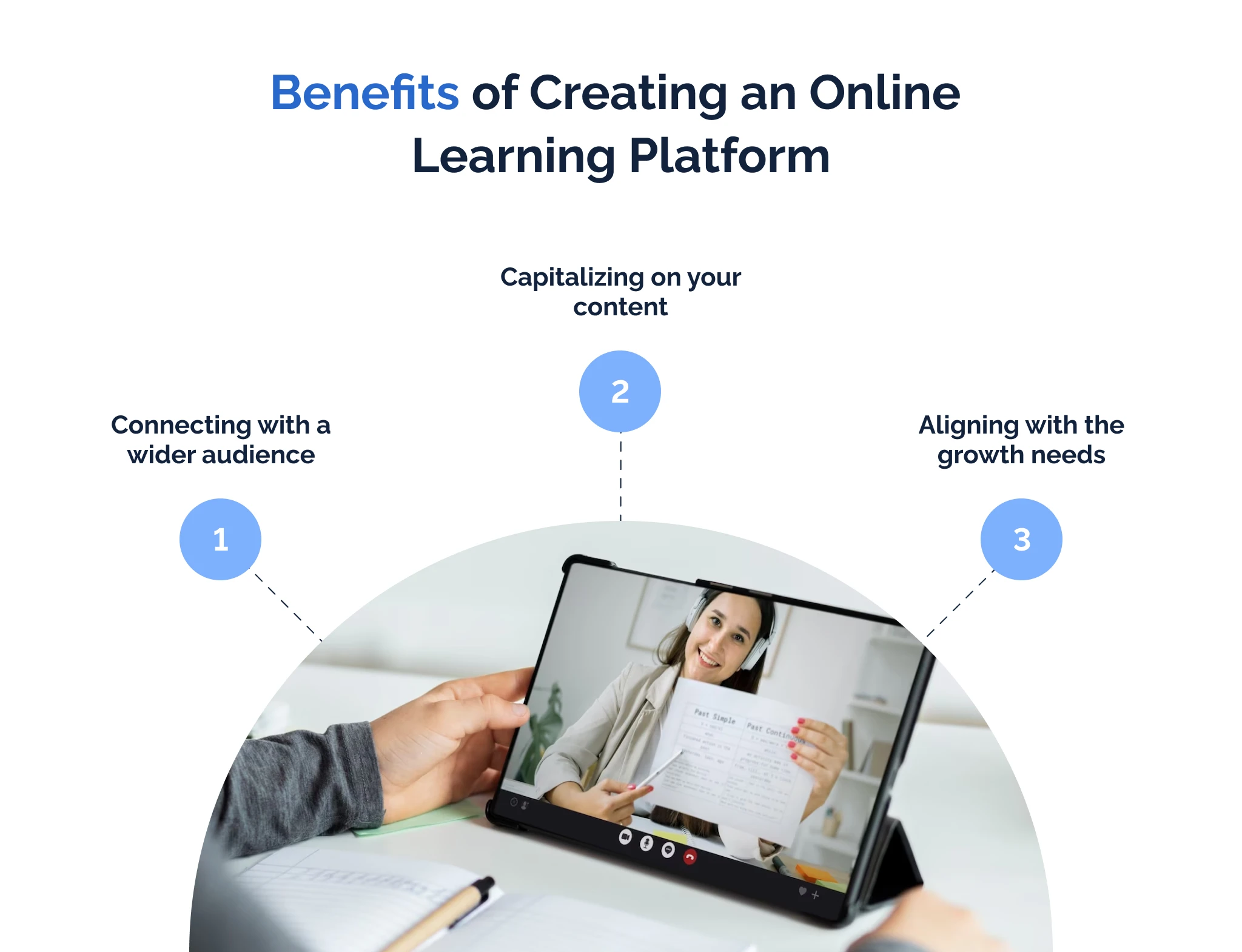
In this section, we look at the benefits of creating an online learning platform from the standpoint of a firm already present on the market. The benefits of creating an online learning platform from scratch are obvious: one can entice users with a high-quality product. But what about a business in, for example, the programming education sector? Is it worth it to invest in online learning platforms for them? In reality, multiple reasons exist for firms to start their online learning platforms.
Connecting with a wider audience
Imagine a firm promoting an innovative offline (on-site) English learning course with a good structure and great learning outcomes. That’s a good business model, and it can bring long-term benefits to the firm. Why go for online courses in such a situation? The reason is simple: you get an opportunity for better customer outreach. This approach solves multiple long-term problems for your business. Firstly, it allows you to secure innovations and ensure that you control them in every market. Secondly, a major reason to develop an e-learning platform is to diversify your business. The recent example of COVID-19 lockdowns proves the importance of having a backup segment for your business. Offline education companies suffered greatly with the beginning of the lockdowns. Lastly, online courses enable regional expansion: greater brand viability can help you open up offline facilities in other locations. With this, your business has greater safety as it no longer depends on stability in one place.
Capitalizing on your content
By focusing only on offline or on-site usage, you limit the overall income from the relevant product. If you create an online learning platform, it can offer a great chance to earn more funds from the content you already have. Many educational companies possess great courses: to earn more money from them, it’s necessary to digitalize the relevant information. When keeping your products offline only, you’re wasting an opportunity to earn more funds. Online learning platforms are a perfect way to capitalize on your knowledge. The earlier you start one, the lower the chance someone else would use a similar idea and earn funds online instead of you.
Aligning with the growth needs
One of the key goals for a business is to expand. A stagnating business is one step away from failing. An online learning platform provides a logical expansion path for many businesses. If you already have a learning company, investing in online platforms makes sense because you capitalize on your expertise and go for the easiest direction. Do you struggle with understanding how to grow your learning business further? In this case, don’t hesitate: expansion into the online learning platform is a reasonable step. Current data by Statista, the largest statistics service on the web, highlight that the online learning platform business will grow by 3.22% annually in the upcoming four years. This information means that investments in the sector are a strong choice for a business looking for expansion opportunities.
Top Features of e-Learning Platforms
Now that we know the key advantages of investing in e-learning platforms, we must consider the features essential for their success. In this respect, five features are crucial when you develop an e-learning platform. What are those? Let’s look at the following:
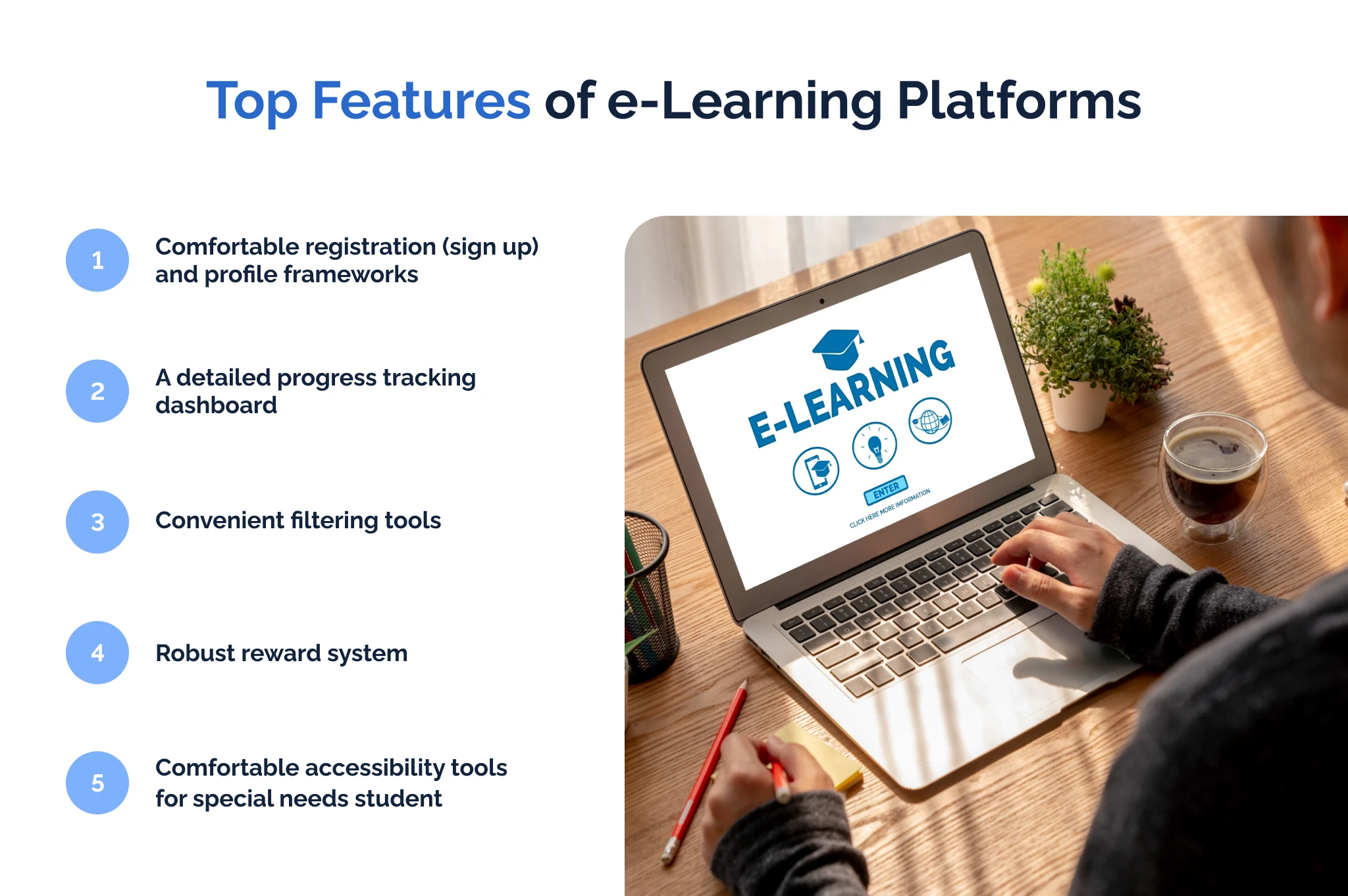
#1: Comfortable registration (sign up) and profile frameworks
The key advantage of online learning platforms is that they deliver personalized experiences to many clients. One can learn at their pace and sometimes even choose the materials they need. To ensure this feature functions well, it’s crucial to let users have individual profiles. Our advice here is to ensure that the registration process is simple. People should be able to create their individual profiles quickly and without major barriers. This approach ensures the maximal interest of the users and their willingness to use your service further. As for the profile systems, they enable all the other features we mention below.
#2: A detailed progress tracking dashboard
Many students lose motivation because they don’t understand their progress. A common assumption is that learning is a linear process. According to this view, knowledge and skills accumulate in it gradually. As Fluentu, one of the largest online language learning platforms, notes in its blog, many people encounter rapid learning periods interspersed with plateaus requiring massive effort to overcome them. In this respect, a progress tracking dashboard becomes essential. Why? While progress may be invisible from a learner’s standpoint, it can still register well in statistics. A good dashboard shows a person they’re progressing in their learning despite the subjective feelings. This approach is perfect for boosting drive to learn something. A dashboard is also a perfect framework for understanding one’s weak points. Experienced learners derive valuable information from them to boost their knowledge.
#3: Convenient filtering tools
Sorting and filtering are essential when you create an online learning platform. Many courses are big and involve a large amount of information. The learning process requires repetition and analysis of particular elements. Finding relevant information is more difficult if you don’t have a filtering system within your learning app. A user must go through the entire course to discover a particular standpoint. Sorting resolves this problem by allowing the learners to find the information they need within several clicks. Competition in the learning market is significant; to differentiate yourself from others, ensuring users’ comfort is central. Learning is a long-time investment: people are more likely to spend time on a comfortable platform. Small features like filtering are central to success in this sector.
#4: Robust reward system
Praise is a vital part of learning. As specialists at the American Psychological Association highlight, praise enhances student resilience and long-term learning outcomes. How to build an online learning platform that works? It should offer the students some rewards for their success. It’s not enough to tell a person they have progressed: they also must receive some emotional feedback. What forms are good for online learning platforms? In this regard, we recommend investing in video-game-like achievement systems and even leaderboards. A good example of this approach is Duolingo. It praises the users for maintaining learning streaks and, more importantly, provides a leaderboard enabling one to understand how good they’re compared to other learners. If a student is successful, they should receive some decorations for their profiles or points that allow purchasing merchandise from an internal shop.
#5: Comfortable accessibility tools for special needs students
Many companies don’t offer good accessibility to the users. This approach harms their business model: they lose access to many users. A common misconception is that people with special needs aren’t numerous. It stems from the belief that only visible disabilities matter. In reality, many people suffer from conditions that are difficult to distinguish. What are the real figures regarding disabilities? Centers for Disease Control and Prevention note 1 in 4 adults in the U.S., or 61 million grown-up individuals have special needs regarding their everyday activities. When you decline to add accessibility features to your business, your company risks losing a quarter of the potential users. We recommend providing vision, audio, and mobility-related tools to ensure maximum coverage. Considering that many companies ignore this aspect, such an investment delivers a perfect opportunity to boost your business.
Exploring the Diversity in E-Learning Platform Development
The e-learning ecosystem has witnessed a remarkable transformation in the preceding years. As a result, various platforms emerged to cater to the diverse needs of learners and teachers. In this regard, e-learning platform development, including both websites and apps, plays a pivotal role in shaping the educational landscape.
Learning Management Systems (LMS): Shaping Institutional Learning
One of the cornerstones of e-learning platform development is the proliferation of Learning Management Systems (LMS). LMS platforms streamline the administrative tasks associated with course management. In this way, they provide a centralized hub for educational institutions. A user-friendly interface enhances accessibility, ensuring that educators and learners alike can navigate seamlessly through the extensive catalog of courses offered.
Massive Open Online Courses (MOOCs): Bridging Global Education
Massive Open Online Courses (MOOC) are becoming popular all over the world. Today, they revolutionize the way individuals access education. MOOC platforms offer a wide range of courses from institutions worldwide, democratizing education. The emphasis on user experience in MOOC platforms enhances engagement. Consequently, they’re popular choices for those seeking flexible learning opportunities. E-learning app development has further extended the reach of MOOCs, allowing users to learn on the go.
Corporate Training Platforms: Tailored Solutions for Professional Development
Specialized platforms for training corporate users have become integral to workforce development. These platforms offer tailored solutions, which include interactive modules and assessments. This approach allows one to align those solutions with the specific training needs of organizations. E-learning platform development in the corporate sector focuses on tracking employee progress and delivering a user-friendly interface to optimize the learning experience.
Online Training and Coaching Platforms: Personalized Learning Journeys
Online training and coaching platforms cater to individuals seeking personalized guidance. These platforms offer interactive sessions, real-time feedback, and user interfaces conducive to one-on-one interactions. E-learning app development in this category often integrates a wide range of features that facilitate seamless communication between instructors and learners. In this way, it creates a virtual space for skill development and mentorship.
Social Learning Platforms: Fostering Collaborative Learning
In the realm of social learning, various platforms aim to create a sense of community in online education to replicate the feelings present in traditional classrooms. These platforms leverage social interactions, discussion forums, and collaborative learning tools to enhance the overall learning experience. E-learning website development in social learning emphasizes user engagement. Consequently, it fosters an environment where learners can connect and share insights.
As the e-learning market continues to expand, the development of e-learning platforms and apps remains crucial in addressing the multifaceted needs of educational institutions, corporate entities, and individual learners. The commitment to user-friendly interface, a diverse catalog of courses, and innovative features underscores the dedication to enhancing the overall user experience in the dynamic landscape of online education.
How to Build an Online Learning Platform: Implementation Steps
How to create an online learning platform? Let’s review the vital steps you can take.
1. Review the market and find a good niche
The first step for any business analysis is to review the market. Look at the existing learning solutions in your sectors. What do they offer? What do they lack? Your goal is to find a weak aspect. For instance, if there’s no focus on grammar learning in existing language courses, you should pay attention to this sector. Identify several niches not offered by other companies. In this way, you’ll be able to find multiple ideas enabling an easy entry into the market. The only reason to compete with an existing solution is if it provides a low-quality service. In all other cases, we recommend remembering the lessons of the so-called Blue Ocean Strategy: focusing on a niche with minimal competition is the best way to succeed.
2. Describe your solution and plan its features
Once you understand what niche is the best for developing your product, it’s time to focus on brainstorming. Create a plan for your software. Try to understand how it’ll work and what monetization model is crucial. You should have a clear concept of the relevant product needs before developing. The more you know about the product in question, the better. This knowledge will enable you to better describe the idea to the developers.
3. Find a good development partner
Most learning companies don’t have full-time developer teams. This information means you should find a good development partner. What should you pay attention to in this case? We recommend looking at their experience in the online learning field and the coders’ expertise. Never go for the first choice you see: pick several companies, ask for their consultations, research them as much as possible, and only then make a final decision on the key partner. If you’re interested in a company that knows how to make an online learning platform, contact us. One can find a portfolio and a free project cost estimate service on our site.
4. Find and choose proper core technologies
To embark on the development journey of an online learning platform, the initial step involves the meticulous selection of core technologies. This entails a comprehensive evaluation of frameworks aligning with the platform’s objectives. The scalability and flexibility of the chosen technologies are paramount. Only they can lay the foundation for future enhancements. The performance and user experience hinge on this critical decision, influencing the overall responsiveness of the platform. A strategic approach to core technologies ensures a robust and adaptable infrastructure that can support the platform’s growth and evolution over time.
5. Create high-quality UI/UX design
Following the selection of core technologies, the focus shifts to creating an exceptional User Interface (UI) and User Experience (UX) design. This phase is pivotal for enhancing engagement and facilitating seamless navigation. A visually appealing and user-friendly interface is complemented by personalized content delivery. It’s essential for enriching the overall learning experience. The implementation of UI/UX best practices necessitates an in-depth comprehension of user behavior and the incorporation of interactive elements. This step contributes significantly to the platform’s attractiveness and usability, ensuring learners are motivated and actively engaged.
6. Engage in development
With core technologies and UI/UX design in place, the development phase takes center stage. This critical step involves translating the chosen technologies and design elements into a functional online learning platform. A key feature in this stage is the implementation of customized courses, which require a flexible and scalable architecture. The platform must seamlessly integrate a diverse range of educational content. Simultaneously, user feedback mechanisms are integrated to ensure continuous improvement and responsiveness to learner needs. This iterative approach is vital for refining the platform and maintaining its relevance in the ever-evolving landscape of online education.
In parallel, core features come to the forefront during development. Personalized content delivery ensures learners receive tailored educational materials, enhancing their engagement. Offering customized courses allows educators to adapt content to the unique needs of their audience, fostering a dynamic and effective learning experience. To broaden the platform’s appeal, the adoption of a freemium model can be instrumental. Basic services are offered for free, enticing users to explore the platform, while premium subscriptions unlock additional feature lists, creating a sustainable revenue model. Additionally, the integration of an admin panel becomes crucial for effective platform management, providing oversight into user activities, progress monitoring, and content management. The admin panel is instrumental in maintaining the platform’s integrity by regulating user access and permissions.
In conclusion, the journey of building an online learning platform involves meticulous steps, with a strategic approach to core technologies, a focus on UI/UX design, and active engagement in the development process. Prioritizing core features and adopting business models like freemium enhance the platform’s overall success, ensuring its competitiveness in the dynamic landscape of online education.
7. Test your app with real users
A big mistake for many developers is releasing an app without consulting the potential audience. Many ideas seem great on paper but underperform in reality. What should you do to avoid this problem? We recommend recruiting potential users and testing the app with them. Feedback helps achieve two goals. Firstly, it’s essential to understand if an app idea works at all. Secondly, it helps with realizing what mistakes are present in the existing framework. With this information, one can resolve any potential errors and ensure the long-term stability of the user base.
8. Launch and maintain your app
If your idea works, it’s time to finish building an e-learning platform. What should you do? Launch the relevant online learning platform and start thinking about improving it. No project launches in a perfect state. Your goal is to continue adding features that the users want. Constant updates are a positive sign for many clients: the readiness of a company to update a platform means the users can also invest their time into it.
Top Technologies You Can Use to Create an e-Learning Platform
Finally, let’s look at the top technologies you can use for creating an e-learning platform:
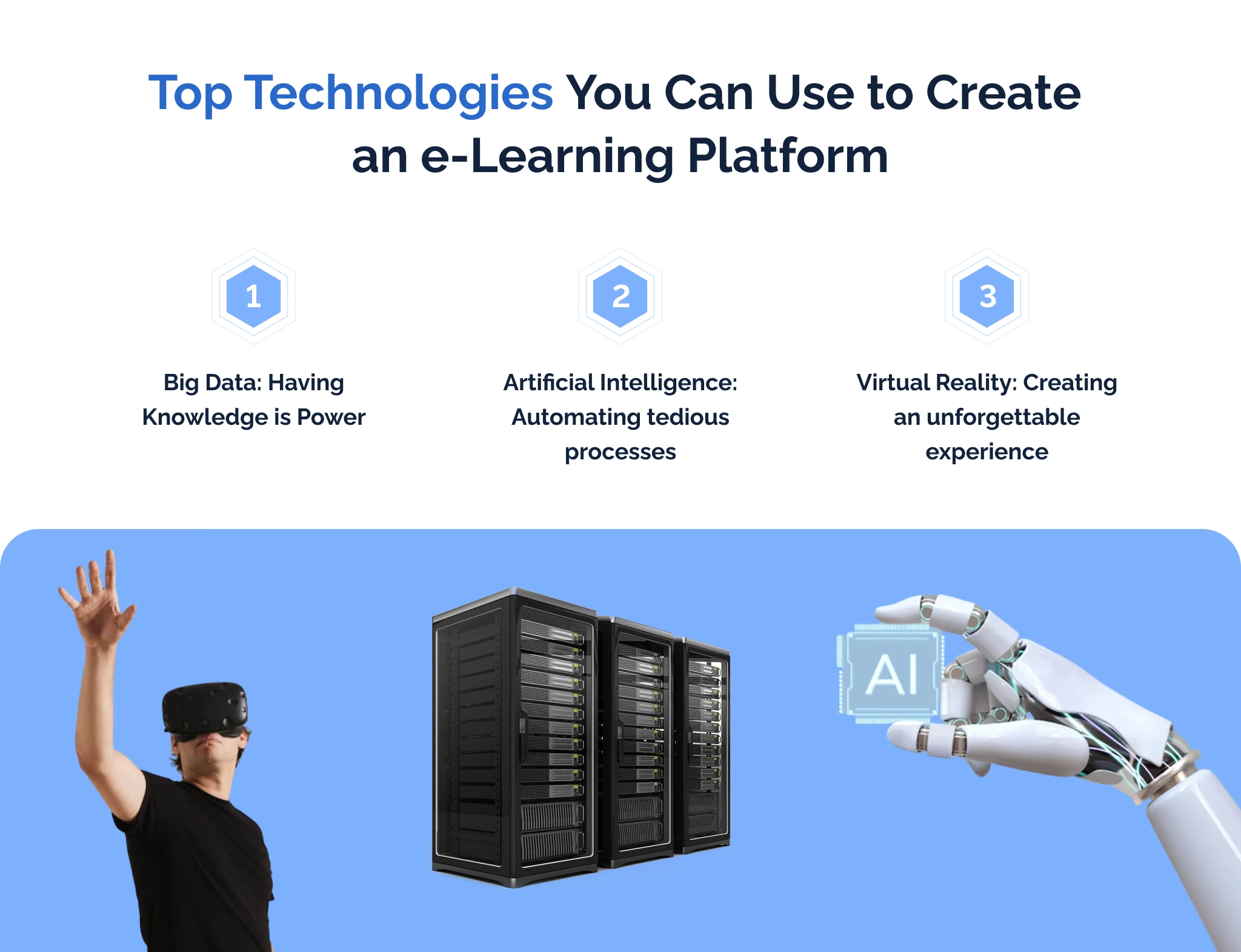
#1: Big Data: Having Knowledge Is Power
The first technology to consider in modern learning platforms involves information management. Big Data includes the analysis of small trends in user information for creating complex conclusions about their learning. Why is this important? Big Data helps users find the weak points in their learning patterns. This approach is perfect for speeding up the learning process. Big Data may also be great for improving a learning service itself. Knowing learner trends, an online learning platform can capitalize on the most powerful teaching methods. Big Data offers a tremendous advantage to companies using it: knowledge is power.
#2: Artificial Intelligence: Automating tedious processes
Modern generative language models can create human-like texts and, more importantly, react to user prompts with high accuracy. Integrating such technology into your online learning service is an opportunity to boost it. How? Above all, AI can become a personal learning assistant for all users. Connect an AI to your knowledge database. In this way, it’ll give correct answers to many user questions regarding your courses. The possibilities of this technology are endless: one can use it to explain difficult concepts in simple words or even generate answers to questions not covered in class.
#3: Virtual Reality: Creating an unforgettable experience
Many people consider learning to be a tedious process. How to build an online learning platform attracting people in the long term? It has to feature an element of entertainment. Apart from ‘serious’ learning, you should be prepared to deliver some moments focusing on fun. Virtual reality is a perfect opportunity to do this. With such tools, app developers can create unique experiences that will push users to return to your service. For example, biology teachers may use VR to show how human anatomy appears from the inside. The idea, in this case, is to be as original as possible: use impressive situations to create an emotional connection for learning concepts.
How Much Does It Cost to Develop an E-Learning Platform?
Knowing the development cost is essential if you want to create an online learning platform. In this respect, everything depends on the scope and complexity of a relevant product. The country of origin for the programming specialists also plays a vital role in this case. An average hour of developer’s time in our firm costs between 25 and 50 dollars. You should look at this figure when deciding what to do with development. Our company also offers free estimates for your projects: go to our website to learn how much a product would cost.
Related Services
LEARNING MANAGEMENT SYSTEM SOFTWARE DEVELOPMENT SERVICES
Conclusion
All in all, now you have relevant knowledge on building a strong online learning platform. Do we recommend investing in this sector? Yes! It can boost many companies working in on-site or offline education. If you’re interested in developing an online learning platform, our company is there to help. Contact us: we can offer you some interesting solutions.
Frequently Asked Questions
How can I monetize my e-learning platform?
There are multiple ways in which you can monetize your effective eLearning platform. Firstly, a good idea is to consider a subscription model. If your project is complex and requires long-term maintenance, it makes sense to ask the customers for some form of monthly payment. This model can also come in the form of the freemium approach. You can offer several core features for free but ask additional funds for the extended package of features. Secondly, a strong framework is the usage of advertisements. You can make your app free but show some ads to earn funds. Users who want to avoid them would have to pay some money, but the app should be usable without such premium payment, too. Lastly, you can also set up some form of a shop with premium features for content strategy. For example, one can sell some unique VR scenarios there.
What’s the average development time for an e-learning platform?
The development time for an e-learning platform can vary depending on the scope and complexity of the project. However, on average, it can take anywhere from 6 to 12 months to develop a fully functional e-learning platform.
What are the key features of an e-learning platform?
Key features for an e-learning platform may include user authentication, course creation and management, content delivery, progress tracking, communication tools, assessment and feedback mechanisms, and analytics and reporting capabilities.
What types of e-learning platforms exist?
Types of e-learning platforms include Learning Management Systems (LMS), Massive Open Online Courses (MOOCs), and virtual classroom platforms. Learning Management Systems (LMS) are apps providing tools for creating, delivering, and managing e-learning content. MOOCs are online courses that are open to anyone and typically offer free access to educational resources. Virtual classroom platforms allow for live, interactive online learning experiences, often with video conferencing and collaboration tools.
Why choose Keenethics for building e-learning platforms?
You should choose our company because it has multiple years of experience in app development and has created several education-oriented apps.
Do you want to join this future? Contact us, and we’ll help you create a potent e-learning solution.

